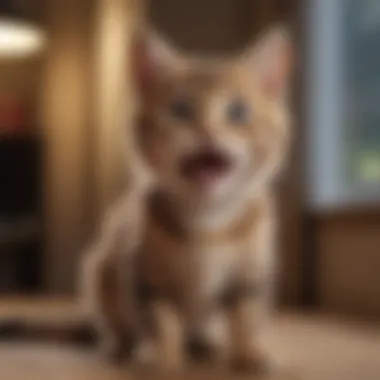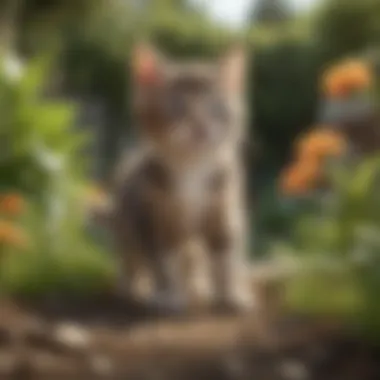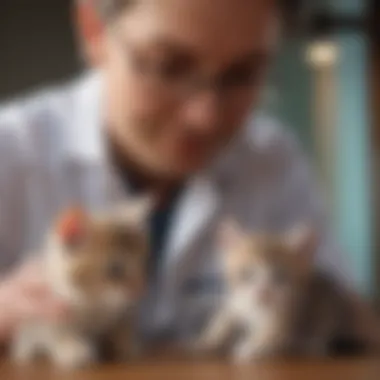Understanding Kitten Panting: Causes and Care Tips


Intro
Kitten panting is a behavior that can raise eyebrows among cat owners. While it may seem strange, understanding why kittens exhibit this behavior is crucial for pet owners. Knowing the potential reasons for the panting can help determine whether it is a normal response or a sign that something is wrong.
In this article, we will explore the various factors contributing to kitten panting. The focus will be on physiological responses, environmental influences, and the potential health issues associated with this behavior.
Moreover, we will provide essential tips on recognizing when veterinary assistance is needed. This guide aims to empower cat owners with knowledge and practical care strategies, ensuring the well-being of their furry companions.
Understanding Your Pet
Breed Traits
Different cat breeds showcase unique traits and characteristics. Certain breeds may be predisposed to specific behaviors or health problems. For example, the Persian cat is known for its calm demeanor, while the Bengal is more active and playful. Understanding these traits allows owners to manage their kittens better and provide adequate care.
Common Temperaments
Kittens, like humans, display a range of temperaments. Some may be more adventurous, while others are shy or timid. Recognizing your kitten's temperament is important. A confident kitten may engage in exploration, while a shy kitten may require more encouragement and patience. This awareness can help in assessing situations like panting, as it may occasionally be related to stress or fear.
Special Needs
Kittens have unique needs that differ from adult cats. They require a balanced diet rich in nutrients to support their growth. Their playful nature also necessitates regular interaction and mental stimulation. Moreover, some kittens may have specific health concerns that might influence behaviors like panting. Being attentive to these special needs promotes a better environment for the kitten.
Pet Care Essentials
Nutrition and Feeding Guidelines
Proper nutrition lays the foundation for a healthy cat. Kitten food should be high in protein and fats, tailored to support rapid growth. Adult food lacks essential nutrients required for kittens, so it is important to feed them specially formulated food. Owner should observe the feeding habits to ensure the kitten is neither overeating nor becoming undernourished.
Grooming Tips and Techniques
Regular grooming is also essential for kittens. It helps maintain a healthy coat and reduces shedding. Brushing not only removes loose fur but can also decrease hairballs, a common concern among cat owners. Introduce grooming gradually to avoid stressing the kitten. Use soft brushes designed specifically for kittens to ensure comfort.
Health and Wellness
Monitoring your kitten's health is vital. Regular veterinary check-ups ensure vaccinations are up to date, and they check for underlying health issues. Signs such as excessive panting can indicate stress or respiratory problems. Early detection of health issues can lead to better outcomes. Paying attention to any unusual behaviors, including panting, is important for ongoing care.
Training and Behavior
Basic Training Techniques
Training should begin early in a kitten’s life. Consistent commands and positive reinforcement are effective methods. This builds a strong bond and increases learning retention. Rewarding with treats or praise reinforces desired behaviors.
Behavioral Problems and Solutions
Kittens might display a range of behaviors that can be problematic. Scratching furniture or biting during playtime are common issues. Providing appropriate toys and scratching posts can help redirect their behavior. Always use positive methods instead of punishment, as this encourages trust and understanding.
Mental Stimulation Activities
Engaging a kitten's mind is crucial. Simple activities, like interactive toys or playing hide and seek with treats, create mental stimulation. An enriched environment keeps them occupied and prevents boredom, which can lead to unwanted behaviors.
Engaging with Your Pet
Interactive Games and Toys
Interactive games keep kittens busy and happy. Toys that allow for chasing or pouncing can cater to their natural instincts. Wand toys encourage physical activity and instill bonding between owner and kitten.
Safe Outdoor Activities
If your kitten is comfortable, supervised outdoor time can be highly beneficial. Short trips in a secure carrier or harness can introduce them to new sights and sounds. Always prioritize safety to avoid risks associated with outdoor exploration.
Family-Friendly Pet Interactions
Encouraging family members to engage with the kitten can enhance its social skills. Teaching gentle handling and appropriate interactions, especially to younger children, is essential. Proper guidance ensures the kitten grows up to be well-adjusted.
Pet Adoption and Integration
Choosing the Right Pet for Your Lifestyle


When adopting, consider lifestyle compatibility. Factors like time available for interaction and your living situation should determine the choice. Some kittens require more attention than others, so it is crucial to find a match that fits your environment.
Preparing Your Home for a New Pet
Prepare a space for the new kitten, with essentials like food, water, and a litter box. Create a safe zone for the kitten to explore gradually. Reducing stress during the initial transition aids in building trust.
Tips for Smooth Foreword
Introducing a kitten to existing pets should be done cautiously. Take it slow and allow for gradual acclimatization. This process can prevent potential conflicts and ensure a harmonious environment for all pets.
Preface to Kitten Panting
Understanding the behavior of kittens can be quite complex. Among the various behaviors exhibited by these young felines, panting is a particular focus. It is crucial to explore why kitten panting occurs and what it signifies for both the animal's health and general well-being.
Panting is often overlooked as just a curious behavior without considering its implications. This can lead to misinterpretation by owners, who may not recognize that panting in kittens is not as common as in adult cats. The importance of this topic lies in the ability to differentiate between normal and abnormal panting, thereby ensuring timely intervention when necessary.
The exploration into kitten panting reveals physiological, environmental, and health-related aspects. By understanding these factors, pet owners can take proactive measures for their kittens' overall health and comfort. This article aims to shed light on these elements, allowing for a more informed approach to kitten care and promoting a healthier environment for young cats.
Defining Panting
Panting is defined as rapid, shallow breathing that can occur in various animal species. In kittens, it is characterized by quick breaths that may make it seem tired or agitated. Unlike humans, cats do not generally pant as a primary means of cooling down. Kittens may exhibit this behavior for various reasons ranging from physiological to emotional responses.
Notably, panting can indicate distress. Whether from overheating, anxiety, or even pain, recognizing why a kitten is panting is essential for appropriate responses. Moreover, understanding this behavior can help owners provide better care. For instance, ensuring a calm environment or avoiding strenuous activities can minimize unnecessary stress on the animal.
In essence, understanding what panting means and recognizing its context are vital for the welfare of kittens. This foundational knowledge anchors pet owners' ongoing relationship with their kittens, ensuring they are well-equipped to respond to their needs effectively.
Physiological Reasons for Panting
Kitten panting is not merely a decorative behavior; it serves critical physiological functions. The act of panting can be seen as an essential response to various stimuli. Understanding these physiological reasons helps owners interpret their kitten's behavior accurately, differentiating between normal actions and signals that may indicate underlying health issues. Knowledge in this area equips pet owners with the ability to provide appropriate care and respond to their kittens' needs effectively.
Thermoregulation
Kittens, like all mammals, require a stable internal temperature to function optimally. Panting acts as a mechanism of thermoregulation, where a kitten disperses excess heat through rapid and shallow breathing. A kitten's body can heat up quickly, especially in high ambient temperatures or after energetic play sessions. When panting occurs, it facilitates the evaporation of moisture from their lungs and tongue, akin to a cooling system.
This method of temperature control is vital, considering that kittens are particularly vulnerable to overheating. Gaining insight into this physiological reaction encourages owners to monitor their kitten's environment. For instance, ensuring that a kitten has access to shaded areas or cool surfaces during hot weather is essential. Owners need to observe their kittens after vigorous play or when they are situated in warmer areas.
Key Points:
- Panting serves as an effective cooling mechanism.
- Rapid breathing allows for heat dispersal.
- Owners should provide a cool environment and hydration.
Stress or Anxiety Responses
Beyond thermoregulation, panting in kittens may also indicate stress or anxiety. Kittens are sensitive creatures, and various factors in their environment can trigger this unsettling behavior. Relocation, the introduction of new pets, or even loud noises can lead to heightened anxiety, resulting in panting as a coping mechanism.
Understanding this aspect of kitten behavior is crucial. Noticing panting in conjunction with other anxiety signs—such as hiding, hiding their ears, or excessive grooming—can lead to a better grasp of their emotional state. Responsible pet owners must recognize when to offer reassurance and a safe space for their kittens.
Some strategies to mitigate stress include:
- Creating a quiet, familiar environment.
- Gradually introducing new experiences.
- Maintaining a routine to confer a sense of stability.
Important Consideration:
Environmental Factors Contributing to Panting
Understanding the environmental factors that contribute to kitten panting is essential for pet owners to ensure the well-being of their furry companions. Kittens, like all animals, are sensitive to their surroundings. Careful management of their environment can significantly reduce incidents of panting caused by external conditions.
When discussing environmental factors, two specific elements stand out: temperature and humidity levels, as well as physical activity levels. Each of these can drastically affect a kitten’s behavior and health. Awareness of these factors allows pet owners to create a more comfortable space and make informed decisions.
Temperature and Humidity Levels
Kittens are more susceptible to heat stress due to their smaller body size and higher metabolic rates. If the ambient temperature rises unexpectedly, panting can become a kitten's primary means of thermoregulation. This panting response helps to cool down their body. Therefore, maintaining a comfortable temperature range is crucial in preventing overheating.
In addition to temperature, humidity plays a significant role. High humidity can hinder a kitten's ability to dissipate heat effectively through panting. As humidity levels increase, the air becomes saturated with moisture, making it harder for kittens to cool down. Ideally, the environment should have a temperature ranging from 70°F to 75°F, with humidity levels kept between 30% and 50%.
Strategies for Maintaining Comfortable Conditions:
- Ensure adequate ventilation in spaces where kittens spend time.
- Use fans or air conditioning to regulate temperature.
- Create shaded areas outdoors or provide cool surfaces for resting.
Health-Related Causes of Panting in Kittens


Kitten panting can occasionally indicate underlying health problems. Understanding the health-related causes of panting is crucial for pet owners who strive to ensure the well-being of their furry companions. In this section, we will delve into specific health issues that could lead to panting behavior. Identifying these issues early can lead to timely intervention and potentially save a kitten's life. Knowing when panting is not just a normal reaction can help prevent serious conditions from escalating.
Respiratory Conditions
Respiratory conditions are a significant concern when it comes to kitten panting. Kittens may develop respiratory issues due to various factors, which can include congenital problems, infections, or environmental irritants. Signs of respiratory problems may include labored breathing, coughing, or nasal discharge.
Some common respiratory conditions that can cause panting in kittens are:
- Asthma: Inflammation in the airways leads to constriction and difficulty in breathing.
- Pneumonia: Infection can fill the lungs with fluid, causing distress and panting.
- Bronchitis: Chronic inflammation may cause irritation and significant coughing.
Pet owners should monitor their kittens closely, especially those exhibiting any unusual signs. It is important to consult a veterinarian if panting is persistent or accompanied by other concerning symptoms.
Cardiac Issues
Cardiac health is another critical area to explore regarding panting in kittens. Heart conditions are not common in young cats, but they do occur. Conditions such as congenital heart defects can lead to ineffective circulation. Symptoms can manifest as panting, lethargy, and fainting episodes.
Common cardiac issues include:
- Hypertrophic Cardiomyopathy (HCM): This genetic condition causes the heart muscles to thicken, impacting the heart's ability to pump blood effectively.
- Heart Murmurs: While not always indicative of serious issues, murmurs may signal underlying problems that need assessment.
Monitoring a kitten's exercise tolerance and observing their behavior during physical activity are important. If panting occurs frequently, especially during light activity, it warrants investigation by a veterinary professional.
Infectious Diseases
Infections can affect various body systems and lead to panting in kittens. Viral, bacterial, or parasitic infections can all contribute to respiratory distress. Common infectious diseases that should be considered include:
- Feline Infectious Peritonitis (FIP): This viral infection can lead to respiratory signs if the lungs are affected.
- Feline Calicivirus (FCV): Known for causing respiratory problems, this virus can lead to heightened panting, especially if the kitten has difficulty breathing due to swelling or mucus.
- Toxoplasmosis: A parasitic infection that may impact overall health and can cause symptoms like fever and lethargy coupled with respiratory distress.
Being proactive about vaccinations and regular vet visits can make a substantial difference in prevention. Pet owners should recognize that symptoms such as panting may appear subtle but often require prompt attention.
An early approach to addressing health-related causes of panting can drastically improve a kitten’s quality of life.
Distinguishing Normal Panting from Abnormal Signs
Understanding when panting is a normal response and when it indicates a potential issue is vital for kitten owners. This distinction can greatly influence the well-being of the animal. Awareness of normal vs. abnormal panting helps in early detection of health problems, allowing prompt veterinary care when needed. A holistic approach toward observing a kitten’s behavior contributes significantly to its overall health and happiness.
Normal Behavioral Patterns
Panting in kittens may occur under various circumstances. It can be a normal physiological response to heat, excitement, or exertion. For instance, after vigorous play, a kitten may pant as a way to cool down. Common characteristics of normal panting include:
- Moderate frequency: Breathing in a quick succession but not excessively.
- Shallow breaths: Breathing may appear light and not labored.
- Contextual triggers: Notice panting occurring after physical activity or during hot weather.
Recognizing these normal patterns enables owners to assess their kittens accurately. Keeping an eye on behavioral context helps determine if it's benign. Additionally, kittens may exhibit a relaxed demeanor even while panting; they return to normal breathing speed promptly after calming down.
When to Worry
While some panting can be normal, there are indications that signal a problem. Abnormal panting can be associated with health emergencies. Pet owners should be alert to the following signs:
- Labored breathing: If the kitten seems to struggle to breathe, it is critical to act.
- Prolonged panting: Continuous panting that lasts longer than a few minutes should raise concerns.
- Accompanying symptoms: Look for signs such as lethargy, cough, or any unusual behavior.
- Color changes: Pale or blue-tinged gums indicate oxygen deprivation, requiring immediate attention.
Prompt assessment by a veterinarian is crucial for identifying underlying issues. Never hesitate to seek professional help if something seems off.
Monitoring patterns in overall behavior, along with changes in resting state, may also provide insights. Differentiating the nuances of panting behavior cannot be overstated. Understanding normal from abnormal is essential for safeguarding your kitten's health.
Observational Guidelines for Pet Owners
Understanding how to observe and interpret kitten panting is crucial for every pet owner. This section will provide insights into what to look for when monitoring your kitten's breathing behavior. Being attentive to these details can help in identifying whether your kitten is experiencing standard physiological responses or if something more concerning needs attention.
Evaluating Breathing Patterns
Evaluating a kitten’s breathing patterns involves careful observation of the rhythm, rate, and depth of breaths. Healthy kittens typically breathe at a rate of 20 to 30 breaths per minute while at rest. Here are some elements to note during evaluation:
- Rhythm: Assess if the breathing pattern is steady or irregular. Irregular patterns may indicate distress.
- Rate: Count the number of breaths in a minute; anything significantly above the normal can be a sign of concern.
- Depth: Observe if the breaths are shallow or deep. Shallow breathing may suggest respiratory issues, while deep, labored breaths hint at stress or other conditions.
Keeping a log of these observations can be beneficial, especially if you notice any sudden changes over time. A consistent record will provide helpful information should a veterinary consultation become necessary.
Recognizing Accompanying Symptoms
Recognizing other symptoms that accompany panting can lead to a more accurate assessment of your kitten’s health. Some signs to watch for include:


- Coughing or Wheezing: These sounds can be an indicator of respiratory distress.
- Lethargy: A decrease in energy levels might point towards underlying health problems.
- Changes in Appetite: If your kitten is panting and also eating less, this could reflect a health issue.
- Vomiting or Diarrhea: These digestive issues can accompany panting in cases of illness.
- Changes in Behavior: Increased hiding or aggressive behavior may signal anxiety or discomfort.
Paying close attention to both panting and these accompanying symptoms can provide vital clues to your kitten’s well-being.
Veterinary Consultation: When and Why
Veterinary consultation is crucial in understanding the panting behavior in kittens. Kittens can exhibit panting for a variety of reasons, some of which can be serious health concerns. Early intervention can prevent complications that may arise from delayed treatment. It is important for cat owners to recognize when panting may signal underlying issues that require professional evaluation. Consulting a veterinarian can provide peace of mind and insights necessary for addressing any health concerns related to panting.
Key Points to Consider:
- Panting may indicate both physiological responses and health-related issues.
- The expertise of a veterinarian can help differentiate normal behavior from signs of distress or illness.
- Prompt consultation could lead to timely diagnosis and effective treatment options.
“Often, when owners observe unusual behaviors in their pets, it is prudent to seek expert advice to avoid unnecessary complications.”
Common Diagnostic Procedures
When a kitten is presented for panting, veterinarians follow a systematic approach to diagnose the underlying causes. They may implement several diagnostic procedures:
- Physical Examination: The veterinarian will assess the kitten's overall condition, listening to the heart and lungs to detect abnormalities.
- Blood Tests: These can reveal underlying infections or conditions affecting organ function.
- Radiographs: X-rays evaluate respiratory structures and help identify any potential obstructions or lung-related problems.
- Ultrasound: This imaging technique can be employed to examine the heart for cardiac issues that may contribute to panting.
- Allergy Testing: If allergies are suspected, tests may determine specific allergens affecting the kitten.
Determining the cause of panting effectively requires a combination of clinical observation and diagnostic tools.
Potential Treatments for Underlying Issues
Treatment plans depend largely on the diagnosis established through the aforementioned procedures. Various approaches may be considered:
- Medications: If respiratory infections or conditions are diagnosed, antibiotics or anti-inflammatory medications might be prescribed.
- Oxygen Therapy: In cases of severe respiratory distress, supplemental oxygen can help alleviate symptoms.
- Surgery: Certain conditions, like obstructive airway issues, may necessitate surgical intervention.
- Environmental Adjustments: A veterinarian may recommend changes to the kitten's environment to reduce stress or allergens.
- Behavioral Therapy: Stress-related panting might require behavioral interventions, potentially involving consultation with a pet behaviorist.
In summary, veterinary consultation is an essential step in addressing kitten panting. Engaging with professionals can lead to accurate diagnoses and tailored treatment plans, ensuring the well-being of the young feline.
Preventive Care Strategies for Kittens
Preventive care is essential for the well-being of kittens. Cat owners should prioritize strategies that can help maintain their kittens' health and mitigate potential issues such as panting. A proactive approach minimizes stress for both the pet and the owner when facing health challenges.
Creating a Comfortable Environment
Creating a comfortable environment is a crucial first step. Kittens, like all animals, thrive in settings that reduce anxiety. A calm atmosphere plays a significant role in how they manage stress and heat. Consider providing a designated space where your kitten can retreat. This can be a cozy bed with soft blankets. Ensure this area is free from noise and disturbances.
Regulate the temperature in your home. Kittens are sensitive to extreme heat. A temperature range between 70 to 80 degrees Fahrenheit is ideal. Use fans or air conditioning during warmer months. Additionally, provide access to shaded areas when outside.
Here are a few elements that can enhance comfort:
- Hiding spaces such as cat trees or tunnels.
- Proper ventilation to facilitate airflow.
- Toys and scratching posts for mental stimulation.
Monitoring Activity Levels
Monitoring activity levels is key in maintaining your kitten's health. Kittens are naturally playful, so understanding appropriate levels of activity will help owners anticipate panting behavior. A balance of play with rest is important. Overexertion can lead to overheating and subsequent panting.
As a pet owner, observe your kitten's behavior during play sessions. If your kitten is panting after a normal play session, it may be a sign to take breaks. Encourage short interactive play bouts followed by rest periods. This not only improves physical health but also fosters a strong bond between owner and pet.
You can establish a daily routine that combines:
- Interactive playtime for physical activity.
- Quiet time where the kitten can nap and recharge.
It’s essential to recognize the signs of overactivity in your kitten. This includes excessive panting, lethargy, or avoiding play. If these signs appear, reevaluate your activity schedule.
By integrating these preventive strategies into your kitten care routine, you can enhance their quality of life. A comfortable environment and mindful monitoring of activity levels will lead to happier, healthier kittens.
The End: Understanding Kitten Panting
Understanding why kittens pant is crucial for their overall well-being. This article explored the multifaceted nature of kitten panting, addressing physiological, environmental, and health-related factors. Each cause plays an important role in interpreting this behavior. By recognizing these elements, pet owners can better care for their furry companions.
The implications of kitten panting are significant. It is vital to differentiate between normal responses due to temperature regulation and abnormal signs that may indicate serious underlying health issues. Owners who are well-informed are in a better position to monitor their kittens effectively. They can take necessary actions when unusual signs present themselves.
Key elements to consider include:
- Physiological Responses: Panting is a natural response for kittens under stress or heat.
- Environmental Influences: Kittens react to their surroundings, and factors like temperature and humidity can intensify panting.
- Health Monitoring: Recognizing when to consult a vet is crucial to prevent escalation of potential issues.
Overall, comprehending kitten panting not only equips pet owners with knowledge but also fosters a deeper bond with their pets. Observing their behavior becomes a proactive measure toward maintaining health. In essence, attentive care and informed responses significantly enhance a kitten's quality of life.
Summary of Key Insights
- Panting is primarily a mechanism for thermoregulation in kittens, but it can also arise due to stress or anxiety.
- Environmental factors, especially temperature and activity levels, can trigger panting.
- Various health concerns like respiratory or cardiac issues must be distinguished from normal panting.
- Observational skills in tracking breathing patterns and accompanying symptoms can lead to timely veterinary intervention.
- Creating a comfortable living environment and monitoring kittens' activity can help prevent excessive panting.
By grasping these insights, kitten owners can ensure they meet their pet's needs effectively. Recognizing when panting may signal distress can lead to appropriate actions that safeguard their health. Ultimately, these steps pave the path towards a happy, healthy, and resilient kitten.



